#Atwood Institute
Photo

Jane Evelyn Atwood : Marginalized Humanity - Blind Magazine
#jane evelyn atwood#institut départemental pour aveugles et déficients visuels#les haut-thébaudières#vertou#france#1981#blind magazine
15 notes
·
View notes
Text
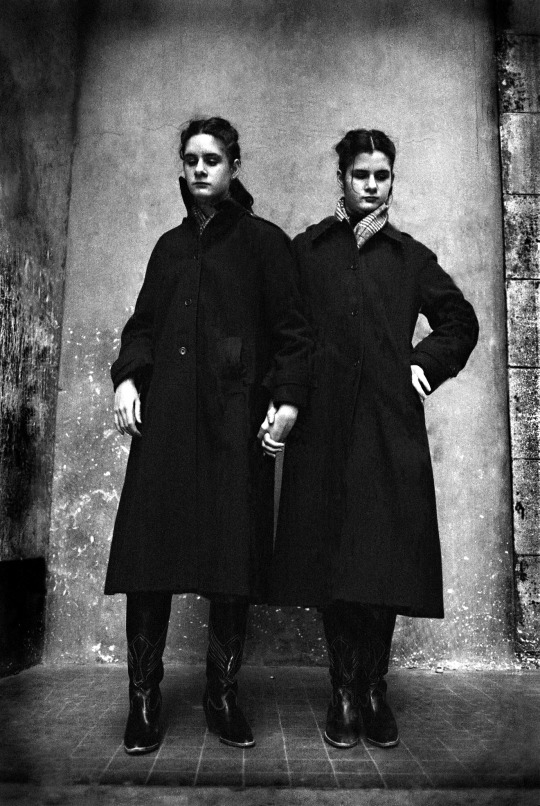
Jane Evelyn Atwood, Les sœurs aveugles, Institut Départemental des Aveugles, Saint-Mandé, Val-de-Marne, 1980.
13 notes
·
View notes
Note
riding the high of seeing challengers twice already means i’ve remembered tumblr (the gifs that will be reblogged..) in time for the monthly book wrap up! coming in thick and fast are we in a post-Easton Ellis world? where did your april reading take you and what’s on the horizon for may?
I've heard that's the movie of the moment!! do you think we'll see a cultural resurgence of casual tennis and all the clouty pickleball courts soon to be taken over by tennis as the lord intended? much 2 think about ..... april was laughably not a big reading month for me ugh so i'll take a page from ur book + talk about some fav watches




The Edible Woman by Margaret Atwood
my first Atwood! reminded me of The Vegetarian by Han Kang with its theme of appetite linked to interpersonal relationships + unraveling sense of self (in fact this book might've popped on my radar bc of its association with it). I liked how each character had their own quirks + weird shit going on too, made the stakes that much more layered and set a kinda zany world for the plot to unfurl in
Less Than Zero by Bret Easton Ellis
finally acquainted with Mr Ellis... not as graphic as I was expecting it to get but I suppose it's his debut + ultimately a different subject matter/world than American Psycho so Understandable! very sparsely + unfeelingly written which I might've read as lazy had I read it years ago but luckily I'm a dedicated student at the Dennis Cooper Institute of Mundane Morbidity so I can appreciate the detachment as an effective vehicle for plot/development. a little repetitive and predictable after a certain point but I think that was the point of it all. im excited to dive into his later / more thorough works!!
Fan Fiction: A Satire by Tavi Gevinson
not actually a book but a 75 page zine that I devoured in one sitting truly unable to rip my eyes away, so im counting it. rookie mag + tavi were staples for me as a teen and tho I was never a swiftie, she also very much aligns with teenage years in my head + she's also just the perfect subject for this kind of piece so this was incredibly nostalgic... so playful and clever and funny and weird, reminiscent of I Love Dick by Chris Kraus with unreliable + obsessive narrator in autofiction form. RPF is actually very ethical and fun when it's this well-formed methinks
The Adjuster (1991) dir. Atom Egoyan
this is only my 4th Egoyan but I'm so amazed at how he portrays desire and obsession and detachment in an equally unsettling and blasé way, images that stay on my mind weeks later. I feel like I consistently see a lot of praise for Arsinée Khanjian's performance in his films (rightfully so!!), but Gabrielle Rose is such a queen of haunting intensity I just can't not stan!!!
Young Soul Rebels (1991) dir. Isaac Julien
really fun sexy cool giallo set in late 70s london. amazing soundtrack and costume / set design, cultural/racial/sexual clashes expertly touched on in both explicit + subtle ways. Julien has such an incredible eye for detail, I wish he'd make more narrative films
Girls Town (1996) dir. Jim McKay
sensitively nuanced and surprisingly (for being directed by a man) realistic portrayal of girlhood with another great soundtrack + costume design moment. just felt incredibly real between the friendship dynamics and adolescent handling of difficult topics - the kind of movie I wish I'd come across a decade ago but am grateful I got to see such a beautiful restoration of it
Hustler White (1996) dir. Rick Castro, Bruce LaBruce
WOOOOOOF tony fuckin ward........... hard for me to focus on much else at the moment but wow this was so sexy and funny like surprisingly slapstick at times?? i mentioned it in my letterboxd review, but literally slapstick stumbling into a BDSM scene... just a the perfect convergence of things I love to see on screen, a perfect fun time!!
my sister and I are buddy reading (2) referenced works in Fan Fiction: A Satire + I've got a handful of potential picks for AAPIHM reads, probably leaning more towards the nonfiction route bc this JCO short story collection has maxed out my capacity for fiction at the moment
15 notes
·
View notes
Text
relationship with margaret atwood ended, annie ernaux is my new favourite white woman author im parasocially obsessed with
8 notes
·
View notes
Note
I know I'm very late to this compared to everyone here (I'm 30) but I just finished reading the odyssey for the first time and I'm... my heart can't handle it. I already want to read it again. Why did I get to this this late? Anyway, I wanted to ask if you have any recommendations for interesting articles or other books about Odysseus, apart from the Iliad? And Penelope, of course. I just love them. I'm asking you 'cause I saw your posts about Odysseus and Calypso / Circe, and found them very interesting and insightful! Thanks in advance
There's no bad time in your life to read the Odyssey for the first time! I'm so glad you found your way to it and enjoyed it!
In terms of books and articles about the Odyssey, I've been out of the academic world for long enough that I feel like I'm no longer a particularly good source of advice, but I'll toss out a few old favorites:
the film O Brother Where Art Thou - a retelling of the Odyssey set in the Deep South during the Great Depression
the novel the Penelopiad by Margaret Atwood - a feminist retelling of the Odyssey from Penelope's point of view
technically it's more about the Iliad, but Somewhere I Have Never Travelled by Thomas Van Nortwick is a scholarly work that's informed my thinking on Homeric storytelling a lot
And I found some articles on the Odyssey that look fascinating freely accessible (no login needed) on JSTOR! Since some of these are public domain, they may not closely track modern scholarship, but if you're just kinda vibing with the Odyssey right now and are looking for more food for thought on the subject, this ought to get you going in interesting directions.
Rose, Peter W. “Ambivalence and Identity in the Odyssey.” Sons of the Gods, Children of Earth: Ideology and Literary Form in Ancient Greece, Cornell University Press, 1995, pp. 92–140. JSTOR, http://www.jstor.org/stable/10.7591/j.ctvn1tbcw.6. Accessed 14 May 2023.
Coulter, Cornelia C. “The Happy Otherworld and Fairy Mistress Themes in the Odyssey.” Transactions and Proceedings of the American Philological Association, vol. 56, 1925, pp. 37–53. JSTOR, https://doi.org/10.2307/282883. Accessed 14 May 2023.
KAMUF, PEGGY. “Penelope at Work.” Signature Pieces: On the Institution of Authorship, Cornell University Press, 1988, pp. 145–74. JSTOR, http://www.jstor.org/stable/10.7591/j.ctt207g60p.11. Accessed 14 May 2023.
Bassett, Samuel E. “The Proems of the Iliad and the Odyssey.” The American Journal of Philology, vol. 44, no. 4, 1923, pp. 339–48. JSTOR, https://doi.org/10.2307/289255. Accessed 14 May 2023.
Gregory, Andrew. “Circe: An Extract from Homer’s Odyssey (c. 900–800 BCE).” Women in the History of Science: A Sourcebook, edited by Hannah Wills et al., UCL Press, 2023, pp. 23–34. JSTOR, https://doi.org/10.2307/j.ctv2w61bc7.11. Accessed 14 May 2023.
Also, if you liked the Odyssey, I think you'll love Greek tragedy! I recommend starting with Sophocles' Electra, Sophocles' Oedipus the King, Aeschylus' Oresteia, and maybe Euripedes' the Trojan Women.
Thanks for the ask, and happy reading!
33 notes
·
View notes
Text
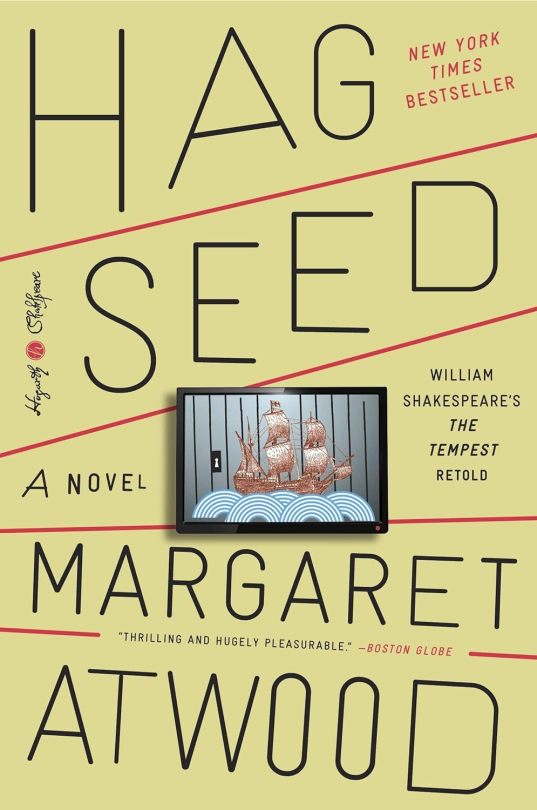
Title: Hag-Seed
Author: Margaret Atwood
Series or standalone: standalone
Publication year: 2016
Genres: fiction, fantasy, retelling, contemporary, classics
Blurb: When Felix is deposed as artistic director of the Makeshiweg Theatre Festival by his devious assistant and longtime enemy, his production of The Tempest is cancelled and he is heartbroken. Reduced to a life of exile in rural southern Ontario - accompanied only by his fantasy daughter Miranda, who died twelve years ago - Felix devises a plan for retribution. Eventually, he takes a job teaching Literacy Through Theatre to the prisoners at the nearby Burgess Correctional Institution, and is making a modest success of it when an auspicious star places his enemies within his reach. With the help of their own interpretations, digital effects, and the talents of a professional actress and choreographer, the Burgess Correctional Players prepare to video their Tempest. Not surprisingly, they view Caliban as the character with whom they have the most in common. However, Felix has another twist in mind, and his enemies are about to find themselves taking part in an interactive and illusion-ridden version of The Tempest that will change their lives forever...but how will Felix deal with his invisible Miranda's decision to take part in the play?
2 notes
·
View notes
Text
Thank you, but I didn’t actually get cancelled in any meaningful way. Valiant attempts were made to drown me (figuratively), but since I don’t have a job I can’t be fired, I’m a tough old bat, I’m too elderly to give much of a poop about my future “career,” it’s not the first hanging party and book-burning featuring myself, and it seems that my Dear Readers were having none of it. Thank you, Dear Readers. It is for you, after all, that I write, not for some craven scholar trying to save her own behind by beating herself up in public for having built her reputation on studies of my oevre. (You know who you are. I accept apologies.)
Why the posse tried to take me down: I signed (and refused to retract, Bad Me!) an open letter to the University of British Columbia (“UBC Accountable”) calling for due and fair process for writer Stephen Galloway, who had been accused — dubiously, it now strongly appears —of rape –a violent criminal act, lest we forget. Nine years later, this claim has still to be thoroughly investigated in a court of law, due to the prolonged and frantic efforts by those being sued for defamation to keep such a trial from happening. But enough preliminary court cases have gone on so that a number of folks have now reversed their snap judgments, and some have gone full Mea Culpa.
You can read all about it in Brad Cran’s Substack called Truth and Consequences; start at the bottom and scroll up. It just gets worse and worse. What was amazing to me was the casualness with which the posse — mostly academics — tossed the Declaration of Human Rights and the Canadian Rights and Freedoms out the window, with cries of “Burn it all down” and the like. But every sword has three sides: your side, the other side, and the Oh Shit! side you didn’t anticipate. Some are now beginning to smoulder themselves, as folks set fire to their feet. Darn, where are those Rights and Freedoms now that a person might need them?
The novelist Margaret Atwood responds in an acerbic style to the attacks she received for having called for due process when the writer Stephen Galloway was accused of rape.
The fact that calling for due process was treated like a crime, while presuming an accusation was true without due process was treated as normal behaviour, shows the level of dystopian tyranny that has overtaken Canadian institutions.
It shows how academics are at the forefront of trashing fundamental pillars of civilisation for the sake of their own ideologies and malignant self-righteousness, which includes smearing and threatening anyone who dares to disagree.
When we acknowledge that many malign tyrannies have been spearheaded by academics (Nazi racism was promulgated by German academics in the 1920's; China's Revolution of 1949 thrived in the universities), then we cannot be surprised by examples such as this.
Such conduct wouldn't be nearly as effective if so many refused to be intimidated and toe the line. When the majority are cowards more concerned about their reputations than about justice, brave voices such as that of Atwood and others who have dared to displease the disciples of currently fashionable movements are seen as radicals: easy to intimidate, abuse, and threaten.
It's time for people to stand up to such intellectual thuggery by defending freedom of speech and the right to the presumption of innocence. When the bullies see that people have a backbone and can't be threatened into silence, they lose their repugnant air of impunity and imagined righteousness.
#margaret atwood#stephen galloway#presumption of innocence#justice#cancel culture#cowardice#freedom of speech#free speech#declaration of human rights#canada#tyranny#academic#academia#politics
2 notes
·
View notes
Text
To take back women’s rights, we need power, commitment and determination. And we need to be unapologetic in claiming the obvious: women are human beings with moral agency and the right to control our own bodies.
When Roe v. Wade was overturned on June 24, the world gasped in disbelief. Polish women did not, however. We had seen it coming, and we know – more or less – what comes next. Since the 1980s, Poland has been a hive of anti-choice activity, one of the few places in the world where the anti-abortion movement’s dreams have become reality. Take a look at a map of reproductive rights in Europe and you will locate Poland at once: bright red, the only country on the continent with an almost total ban.
The anti-abortion movement has a two-tier strategy: there is politics and there is culture. In politics, these actors will support anyone willing to give them access to power, especially the courts, no matter how corrupt and immoral. Donald Trump and Jaroslaw Kaczynski, the leader of Poland’s ruling Law and Justice (PiS) party, are good examples of this pattern. Wherever you look, you will see ultraconservatives engaged in building symbiotic relationships with populist rightwing parties, helping them win elections. When this happens, they push for restrictions on women’s rights and bans on LGBT rights.
The cultural tier has to do with language and public imagination. The strategy is far more insidious than just taking part in public debate. Anti-choice propaganda is relentless, loud, gruesome and repetitive. It ignores reality, it appeals to deep-felt anxieties. It can be brutal, as with images of cut-up, bloody foetuses paraded in front of schools or driven around on the sides of vans. Or eerily sentimental, as with hundreds of thousands of billboards screaming at you from Poland’s streets and highways: “Where are these children?”. They mean those that have never been born. It’s oppressive, but ultimately effective in silencing opposition.
Is Poland different from the rest of Europe because it is more Catholic? Not really. Social views on abortion are only a bit more conservative than those in Croatia, Czechia or Hungary, with polls showing that most citizens want abortion to be legal in at least some cases.
What really sets Poland apart is the political influence of the Catholic Church as an institution, its ability to exert pressure on political parties, the media and the courts. This alliance has much in common with bonds linking Republicans to the religious right in the US. Ever since the late 1970s, US Evangelicals and Catholics have managed to dictate the Republican platform on gay rights and abortion. The deal is simple: give us the courts, and we will deliver the votes. So, when Roe v. Wade fell, I wasn’t particularly surprised. My heart went out to the women in the red states, now trapped in what increasingly resembles Margaret Atwood’s patriarchal dystopia, Gilead. Polish women have lived there for over two decades. And here is what we have learned…
50 notes
·
View notes
Text
Fisher Building, Chicago
343 South Dearborn Street
Completed 1896; addition 1907
Charles Atwood, D.H. Burnham & Co. architects
1907 addition, Peter J. Weber, architect
2001 restoration and adaptive reuse, Pappageorge Haymes, supervising architects
by Roger Jones, August 2023

Fisher Building, photo by Roger Jones
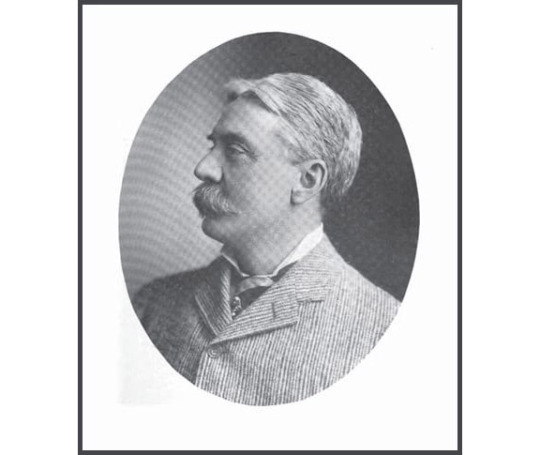
Lucius Fisher (1843-1916). He was a Chicago, Illinois paper company magnate and architect. In 1895, he commissioned Daniel Burnham and Company to build the 20 story, 275 foot tall Fisher Building in the Chicago Loop.

Fisher Building, Chicago, taken April 29, 1896. From The Inland Architect and News Record, May 1896. [Link to full article PDF here]
The writer of the 1896 article described the building thus:
But here, for what we believe to be the first time in human experience, one of the highest commercial buildings in the world has been erected almost without any bricks. It fronts on three streets, and on the remaining side adjoins other property. The fronts are covered with cellular terra cotta on the outside, not in imitation of a wall, but following upward the steel supporting members, and closing in the transoms between the windows, leaving two-thirds of the exterior to be enclosed by glass… Only two bricklayers were employed at any time in this part of the work.
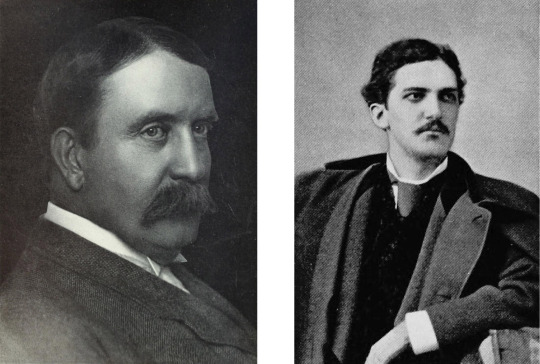
(Left) Daniel H. Burnham (1846-1912)
(Right) Charles B. Atwood (1849-1895)
The Fisher Building, 343 South Dearborn Street in the Chicago Loop, was commissioned by paper magnate Lucius Fisher. The original 18-story building was completed in 1896 by D.H. Burnham & Company; the architect was Charles B. Atwood, who died before the building's completion. An addition was later added in 1907.
Some facts about the building, from the Emporis site:
The original wing was only the second building in Chicago to reach 18 stories (after the Masonic Temple), and is the oldest still standing at that height.
Because of the building's great height for its time, the usual spread foundations were supplemented with piles underneath them to support the added weight.
The second floor was originally a banking room, and has especially large windows compared to the floors above it.
To enhance the facade's vertical emphasis, most of the ornamentation is placed on its horizontal members, reducing the banding effect that would occur if they were blank.
The Gothic ornament is in the 15th century style of Bruges and Rouen.
Declaring the structure a Chicago Landmark in 1978, the Landmarks Division noted:
Cladding this early skyscraper with Gothic-inspired, terra-cotta tracery was not a casual stylistic choice. Its designers looked for inspiration to the early Gothic cathedrals of Europe, which shared common characteristics of tallness and often having more glass than masonry. Cut glass door panel Eagles and mythical beasts decorate the upper stories, and aquatic creatures and seashells--a visual pun on the name of the building's original owner, Lucius G. Fisher--are found at the base. A later addition to the north is largely a repetition of the original design, except for the absence of bay windows.
Early postcard views of the building


Archival photos

Fisher Building under construction (left) and on completion (right)

Van Buren (main) entrance; Lobby stairs

Entrance hall

First story entrance corridor in 1896

Original elevator cage

Original elevators
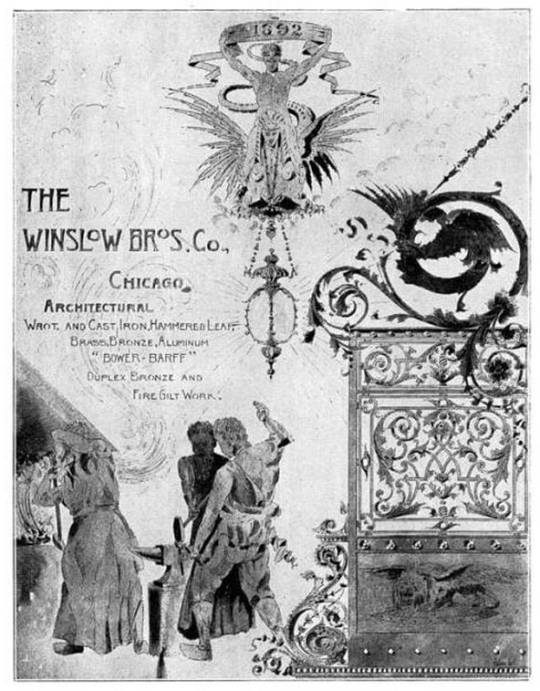
Advertisement for Winslow Brothers, who executed the metalwork for the Fisher Building

Late 19th Century Cast Iron Elevator Lobby Door from The Fisher Building, listed for sale on 1stdibs.com. Compare to original elevators photo above.

Rendering of the 1907 addition, Peter J. Weber, architect
Other illustrations
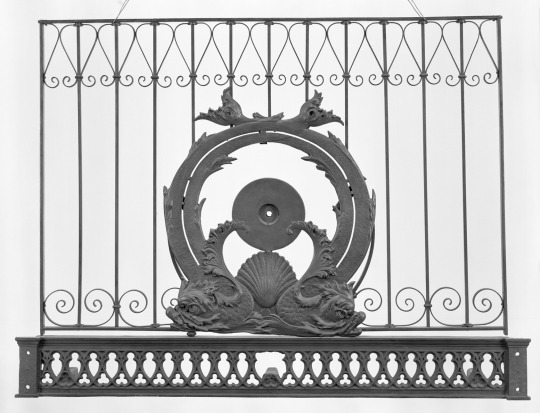
Upper elevator grille. Art Institute of Chicago

Elevator frieze panel. Urban Remains, Chicago.
Architectural Description from the 1965 Historic American Buildings Survey Report [Link to PDF of report here]
PART 11 ARCHITECTURAL INFORMATION
A. General Statement:
I. Architectural character: The Fisher Building is a large office 'building designed by the firm of D. H. Burnham Co. in 1895. It has been cited by the Chicago Landmarks Commission and it is indicative of the level of achievement in skyscraper design attained by the architects of the Chicago School. The steel cage structure is sheathed in a curtain wall of decorative terra cotta and glass, providing ample space and light for the occupants and making it possible for the building to be erected relatively quickly and economically.
B. Description of Exterior:
1. Over-all dimensions: Rectangular 70'-6" (five-bay south front) x 150' 0" (eleven-bay west front), including addition. Eighteen stories.
2. Wall construction, finish and color: The original block of the building had tripartite projecting bays alternating with planed surfaces. Bays end at sill of 17th story. Arches of varying width span the window openings of the 17th floor. The original salmon terra cotta finish is now coated with a black patina from the soot and dirt of the city.
3. Openings:
a. Doorways and doors: The arched entrance on VanBuren Street, originally the principal entrance, is intact; that at 343 South Dearborn Street has received a 20th century I 'modernization"--a polished granite portal with plate glass and aluminum doors. The original doors from the vestibule inside are decorated with an ornamental fish cut in the glass panels.
b.. Windows: Mostly one-over-one light, double-hung windows; those of the original building are grouped three to a bay window, two between; in the north addition, the windows are placed in a plane in groups of three. At the 17th floor the lights are gathered under wide arches; at the 18th they are again in threes with transoms above. The first floor display windows have been disfigured by a variety of signs, aluminum panels, and other attempts at commercial modernization.
...General setting and orientation: The buiIding occupies the southern portion of a narrow block at the south end of the Loop. Its neighbors are the Old Colony Building (HABS No. ILL-1053) to the south and the Monadnock BuiIding (HABS NO. ILL-1027) to the west. The buiIding fronts the sidewalk line on three sides and is adjacent to the elevated on VanBuren Street.
Prepared by Larry J. Homolka, Historian and Assistant Supervisor National Park Service August, 1965.
My Photos:





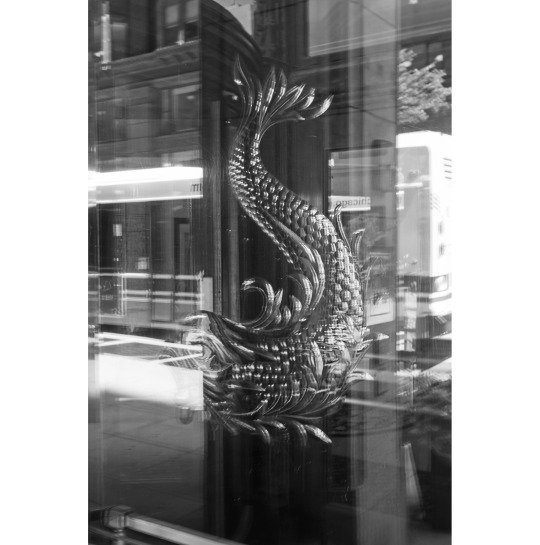

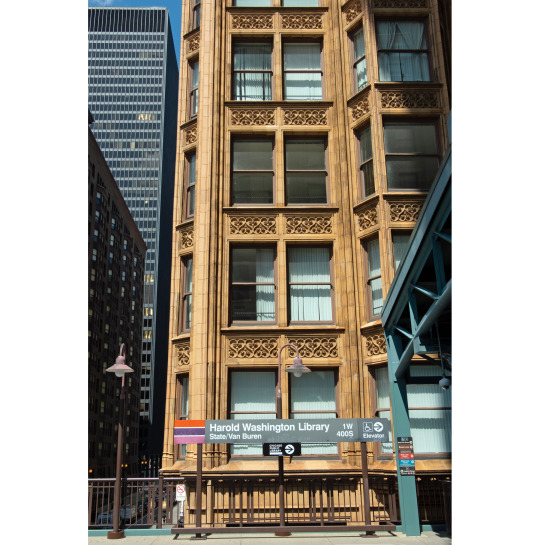
Links / Sources:
Architecturefarm - old chicago skyscraper of the week–Fisher Building
Chicagology
chicago.designslinger
Emporis Buildings on the Wayback Machine – Fisher Building Chicago
HABS Report 1965
Historic Structures
cityclubapartments.com - Daniel H. Burnham's Fisher Building interior lobby original elevator doors executed by Winslow Brothers
Chicago Landmarks - Fisher Building
Researchgate
Urban Remains - Fisher Building
Urban Remains - Fisher artifacts
Wikimedia commons
#Fisher#Fisher Building#architecture#Chicago#DH Burnham#Charles B. Atwood#skyscraper#terra cotta#landmark#Peter J. Weber
4 notes
·
View notes
Note
For the English classes, how about "Arthurian myths & adaptations" or "the theme of marriage"?
As far as Arthuriana goes, I’m only really familiar with The Once and Future King and the musical Camelot. Marriage though… that gets the juices flowing.
I would sort of roughly group the reading list into the unhappy marriages vs the increasingly happy ones, with Middlemarch and Anna Karenina in the middle because they both contrast the two as foils. Some are also grouped by theme (jealousy, the institution of marriage, loyalty, etc.)
A Christmas Tree and a Marriage, Fyodor Dostoyevsky
The Portrait of a Lady, Henry James
The Good Soldier, Ford Maddox Ford
The Winter’s Tale, William Shakespeare
Middlemarch, George Elliot
Anna Karenina, Leo Tolstoy
Here We Are, Dorothy Parker; compare the short story and the play
The Good Earth, Pearl S. Buck
To the Lighthouse, Virginia Woolf
Poetry about marriage: Anne Bradstreet, Anna Ahkmatova, Maggie Nelson, and others; the Biblical Song of Songs
Selections from The Odyssey; The Penelopiad, Margaret Atwood
After each text, a short essay (3ish pgs) would be assigned on the topic, “Is x marriage successful or unsuccessful? Why or why not?” Final term paper, “what makes a successful marriage?”, incorporating several different texts.
#this comes out to about 30 classes which is what most of the english classes for my minor were#i'm kind of an outlier in the Knitting Circle in that I actually really love stories about complicated failure marriages#infidelity jealousy#it makes for compelling and revealing literature#so i actually had a comparitively hard time coming up with books about good marriages#heh#ask me hard questions#literature makes us more human#thanks for this one! i had a lot of fun with it
17 notes
·
View notes
Text
Jim Carrey, The Handmaid's Tale author Margaret Atwood, and other notable Canadians were banned from entering Russia in response to Canada's support for Ukraine amid the Russian invasion.
Carrey and Atwood were among 100 names listed by the Russian Foreign Affairs Ministry's ban, with most of those listed being Canadian Ukrainian activists or prominent figures. Many if not all of those listed have expressed opposition to the Russian invasion of Ukraine or the Russian government in general. The newest wave of sanctions was likely in retaliation to reports that Canada was preparing sanctions against Russians. The sanctions were instituted shortly after Russia's newest bans.
BEN STILLER AND SEAN PENN AMONG 25 AMERICANS NEWLY SANCTIONED BY RUSSIA
"In response to the ongoing practice of imposing sanctions by the regime of Prime Minister J. Trudeau against the Russian leadership, politicians and parliamentarians, representatives of the business community, experts and journalists, cultural figures, as well as anyone whom the Canadian Russophobic authorities consider objectionable, entry is closed on the basis of reciprocity for 100 Canadian citizens," the Foreign Affairs Ministry wrote.
"Among them are high-ranking officials, businessmen, activists of numerous pro-Banderist organizations, media and financial structures that are directly involved in the formation of an aggressive anti-Russian course," it added.
The reference to "pro-Banderist organizations" refers to groups the Russian government considers support or emulate Stepan Bandera, who features prominently in Russian propaganda about Ukraine. His grandson, Stephan "Steve" Bandera, was included in Russia's ban.
Carrey has been a vocal critic of the Russian invasion of Ukraine and the Russian government, describing "Czar Putin and his soulless minions" as an "intolerable evil."
#nunyas news#maybe we were too harsh with russia#this sounds like a good thing#keeping jim carey out
10 notes
·
View notes
Photo
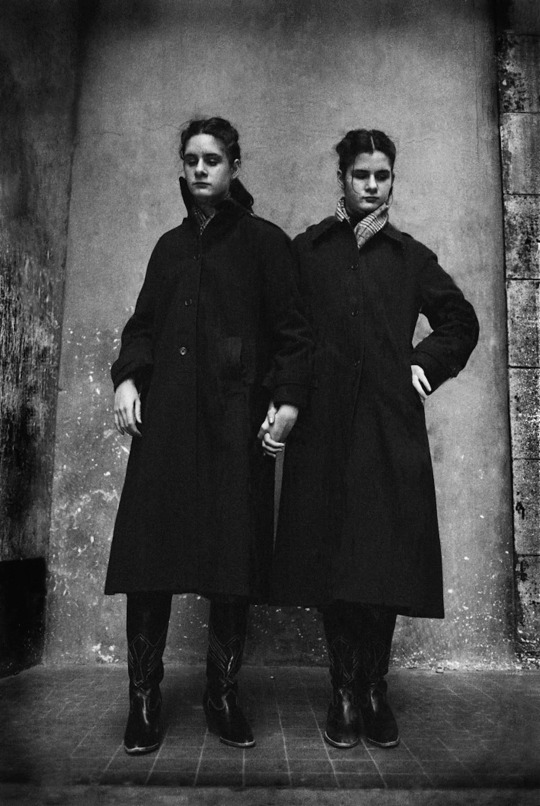
Institut Départemental des Aveugles, Saint-Mandé, France, 1980. © Jane Evelyn Atwood
care of Jane Evelyn Atwood : Marginalized Humanity - Blind Magazine
13 notes
·
View notes
Audio
Dwight Trible - Ancient Future - new album on Gearbox Records with a sweet guest list
Today, the inimitable jazz vocalist, activist, and nominal godfather of the LA jazz scene, Dwight Trible, returns with the announcement of his new album “Ancient Future”. Out 17th March via London jazz aficionados and analog specialists Gearbox Records , the new record follows his critically acclaimed album “Mothership”, which was released in 2019 and saw him collaborate with the likes of Kamasi Washington, Mark de Clive-Lowe, Miguel Atwood-Ferguson, and more.
On “Ancient Future”, Trible collaborates once again with Kamasi Washington (saxophone), as well as lauded LA multi-instrumentalist Georgia Anne Muldrow (vocals), who is signed to Brianfeeder and has previously worked with the likes of Madlib, Denzel Curry, Mos Def, Blood Orange, and Brittany Howard.
Elsewhere, the record also features double Grammy winning pianist, John Beasley; Kamaal Williams touring drummer Greg Paul; gospel bassist André Gouché; percussionist and backing vocalist Megashia Jackson; LA guitarist G. E. Stinson; and percussionist Rene Fisher.
A key figurehead in the LA jazz scene, Dwight Trible is a legend in waiting. With an incredible career spanning decades, he has played a pivotal role in creating as much jazz history through his work and inspiration in the new wave of US jazz, as he should be noted for in his undoubtable vocal and songwriting talent. He is the vocalist for the Pharoah Sanders Quartet and has collaborated with a huge variety of artists such as Kamasi Washington (singing on ‘The Epic’ and ‘Heaven and Earth’), J Dilla, Life Force Trio, Carlos Nino, John Beasley, Bobby Hutcherson, Charles Lloyd, and is also the vocal director for the Horace Tapscott Pan Afrikan Peoples Arkestra - a Los Angeles institution with a history stretching back forty years and an active engagement in the city's Black community since the Watts Uprising.
Trible has also been on the forefront of the US jazz resurgence, working as executive director of the hugely crucial arts space The World Stage - a vital component to Leimert Park, which has been the epicentre of African-American art and culture in Los Angeles since the late 1960s. Artists such as Kamasi Washington and Terrace Martin have credited the venue as having helped to shape their sounds and the sense of community surrounding the scene, whilst also being an essential influence to the likes of Kendrick Lamar and Biz Markey, as well as number of artists from LA tastemaker label Brainfeeder and more.
An avid and passionate activist, an enabler of the local scene and a figurehead in the LA jazz community, Trible’s focus is rarely self-seeking, always facing outward his focus is largely centred on giving, inclusion and teaching, whilst also inspiring others and expressing himself both on-stage on-record behind the scenes.
Dwight Trible; vocals
John Beasley; piano and keyboards
André Gouché; electric bass guitar
Greg Paul; drums and percussion
G. E. Stinson; electric guitar
Megashia Jackson; percussion and background vocals on ‘African Drum’
Rene Fisher; percussion on ‘African Drum’
Kamasi Washington; tenor saxophone on ‘African Drum’
Georgia Anne Muldrow; vocals on ‘Black Dance’
All tracks composed by Dwight Trible, John Beasley, André Gouché, Greg Paul and G. E. Stinson
All lyrics written by Dwight Trible and Megashia Jackson
4 notes
·
View notes
Note
17, 18, and 19 for the book asks!
17. Top five books of the year
skdfjskj this is ABSURD to try to narrow down BUT. in no particular order:
The Death of Vivek Oji by Akwaeke Emezi
This book basically unravels the mystery of how Vivek Oji died, and explores the lives of a group of queer youths in Nigeria - and the core of the story is the dual experience of wanting to "truly" express oneself while also not being out for the sake of safety, which as someone in a relatively similar situation made me want to scream because the experience is captured so WELL UGH
The Shadow King by Maaza Mengiste
This is such EXCELLENT historical fiction - it talks about the involvement of women in the Italian invasion on Ethiopia as soldiers, spies, etc. and examines the dynamics between them on levels of station, power, allyship, etc. It's so SO SO well written and researched, I finished the entire thing in one sitting
The Song of Achilles by Madeline Miller
I'll be honest I was putting this one off for a WHILE now and finally got to it after seeing your posts about it skfdjsk, the spirit of greek tragedies is alive and well in this one T_T
The Handmaid's Tale by Margaret Atwood
Another one I've kind of been putting off, and haven't watched the show for - the entire book is naturally fantastic and then there's the EPILOGUE which breaks the narrative style into like an academic conference at least a century or two in the future which. HOLY SHIT
The Sandman: Overture by Neil Gaiman
This is technically a six-issue comic run but ssshhh they're good they're so good!!! Not going into this too much bc Sandman spoilers but it's basically a prequel of sorts to the first issue of the Sandman original run (which should absolutely be read before Overture btw, because Overture contains major spoilers from the final Sandman issues) which messes with such concepts of time, reality etc.. Also Dream reveals a bit of a backstory where he was damselled in a tower while a cool lady came to save him from the dangers lurking outside, which is fascinating from a meta perspective of storytelling.
18. Least favourite books of the year
Heart of Darkness by Joseph fucking Conrad. it's both tedious and fucking AWFUL and i hate that i had to read it not once but TWICE this year for two separate classes. if i have my way i'll never touch this book again in my LIFE
Also The Golden Notebook by Doris Lessing. I had such high hopes for this one because the premise sounded interesting as hell but the protagonist is just awful. She's the LEAST compelling person to have written an entire epistolary novel about and her character is the flattest thing on the planet. I've gone on SEVERAL ranting sessions (and even ranted in my essay for the class I had to read it for lol) and suffice to say it's just not my thing
19. Best non-fiction book(s) you read this year
OKAY so there are a few that my professors wrote/recommended that were just incredible but those also involve giving away my location which I really don't wan't to do, but I did read A Feminist Theory of Violence by Francoise Verges and was utterly THRILLED with it!
The book talks through various salient issues (ex. racism, the prison system, sexual violence, capitalism & neoliberalism etc.) and why they don't cross each other out but actually intersect in ways that enrich conversations around these topics individually - furthermore also talks about how the sources of these institutional problems is often very much the SAME thing, meaning they're all interconnected enough that approaching one should, in fact, involve approaching these other structural problems also
Fair trigger warnings for discussion of state violence, racism, rape etc. but it's a genuinely poignant book that I highly recommend!
End of the year book asks
#velli answers#kckenobi#thank you for the ask!#i now have 2 unwanted copies of heart of darkness that i plan on selling/giving away as soon as i'm done with my degree#this got a lot longer than i intended lol
5 notes
·
View notes
Text
Not to be doom and gloom but like… how do we live in this fucking shithole of a country? I want the place I live to be better than this. I want people to have access to healthcare and to be able to walk around without fear of murder or a massacre. I just want to be respected, to be able to live my fucking life and not worry about the fact that I’m trans and how others will view me. And I’m white! I live in a pretty progressive state! It’s not going to be better for people in solidly red states who aren’t white or who are poor or who are a combination of those things. People joke about moving to Canada after elections but I’m gonna be honest, I’m really fucking worried about the direction my country is headed in. I have been for a long time but I think this is when my fear overrides my ability to withstand. I have spent my entire adult life in fear and anger over a progressively more authoritarian conservative movement and I want it to fucking end at some point. Why is it that 6 fucking people can decide to go against the will of the majority of people in the country? A group of like 1000 people total runs this god damn country and they are so fantastically out of touch with the country itself but they don’t have to be in touch as long as corporations and oil barons keep paying them off to do every shit thing imaginable. America is a failed institution, and I am so afraid for what comes next. Joe Biden isn’t gonna be the one to fix it.
Sometimes I think about how Margaret Atwood didn’t write anything in the Handmaid’s Tale that hadn’t already happened in the past to women at some point. About how bleak and sad that story is. About how much I feared that that kind of thing could become reality when I was originally watching the show. It becomes hard to relax when you worry that any week, someone can decide that you are once again an undesirable to be dealt with. I am an anxious person but I think in the face of this country that will not simply let people live, that is a very sane way to take it.
I don’t have a point. I’m just tired. I’m nervous. I’m sad. I feel sick. Today and every day, its important to recognize when the systems you live under are failing you.
2 notes
·
View notes
Text

Archita Mittra Reviews Pomegranates by Priya Sharma
April 4, 2023 Archita Mittra
Priya Sharma’s latest novella, Pomegranates, is a lovely, layered, and luscious retelling of the story of Persephone and Demeter, unfolding against the backdrop of climate change and patriarchal violence. While Greek mythology has been in vogue at least since the success of Rick Riordan’s bestselling Percy Jackson books, Sharma’s novella sits closer to books like Margaret Atwood’s The Penelopiad, Madeline Miller’s Circe, or Natsuo Kirino’s The Goddess Chronicle, all of which employ a detached, feminine voice in rewriting myth and registering tragedy.
Pomegranates has a lilting, poetic cadence to it, and is suffused with a few moments of quiet horror. These are tricks that we previously glimpsed in Sharma’s short story collection All the Fabulous Beasts, in which she wove darkly evocative stories through small vignettes. Incidentally, All the Fabulous Beasts contains the tale ‘‘Pearls’’, a charming retelling of the story of Medusa and Poseidon that unfolds over the centuries and up to the modern age. Vignettes also provide the structure for Sharma’s novella Ormeshadow, a quiet coming-of-age tale set in the English countryside that gently creeps up on you like a sleeping dragon. Pomegranates is perhaps her most accomplished work yet, focusing on the intertwining stories of three women – Dr. A. Ursa (who is possibly related to Hecate, the Moon Goddess); Demeter, the Corn Mother; and Persephone, queen of the Underworld.
The tale begins with a speech by Dr. Ursa at the Swedish University of Agricultural Sciences, where she urges the audience to build a viable seedbank, foregrounding the novella’s ecological themes. This is followed by a clinical record from the August Institute; we infer that Demeter had been wandering the Earth in search of her daughter and is presently under psychiatric care. There is a nice jab here at the Greek pantheon, which is succinctly described as an ‘‘important family’’ of ‘‘sociopathic rapists, despots, egomaniacs and drunkards.’’ We also learn that Hades has died and Persephone rules instead, full of rage and bitterness but ready to narrate her tale to Ursa, who has stumbled into the underworld after traversing an apocalyptic, tundra-like landscape. Meanwhile, Demeter too slowly opens up to her therapist about the violence of the Gods and her subsequent bargain with Hades to protect her daughter from the machinations of Zeus. Thus, in Sharma’s spin on the legend, Persephone is neither seized by Hades to be his wife and nor does she leave of her own volition (as seen in several contemporary retellings).
At its heart, Pomegranates is a story about women wanting to be heard, whose voices have been effaced or distorted through time. It is not surprising, then, that much of Persephone’s narration to Ursa feels as though she is talking to the reader herself. In another particularly powerful moment, Demeter talks to a lawyer about pressing rape charges against Zeus and Poseidon – it is a clever scene that recounts the details of the violence, not as it happened nor in court, but in a series of back-and-forths between lawyer and client that tells the readers all they need to know about the incident and offers a rundown of the ways patriarchy will strategize to discredit a woman’s narrative. There is also deep anger and revenge here – Demeter curses the trespassing and lascivious King Erysichthon to remain eternally hungry, and Persephone, in her mourning, dooms the planet to a nuclear winter (even COVID-19 is part of her vengeance upon mankind, another nice touch) – and it is these scenes, narrated with so little embellishment, that are bound to linger in the reader’s minds long after the book is closed. In the tradition of ancient Greek plays, a chorus appears between sections, inviting the reader to pause and fill in the gaps, rethink their understandings of history, myth and knowledge, and examine the themes of godliness and humanity, power and agency more closely.
While a part of me wishes that there was more to this world and for the tale to go on, another part of me is astounded by Sharma’s ability to hint at so much with so few words. Deliciously evocative, carefully constructed, and filled with just enough detail to keep the reader turning the pages, Pomegranates is a book which can be finished in a single sitting, but deserves to be savored more slowly. It will appeal not only to fans of feminist retellings of myths and folklore, but to anyone on the lookout for a quiet and beautiful novella.
1 note
·
View note